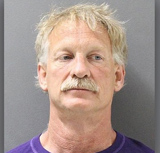This article first appeared on Wildfire Today.

A man was arrested in Prescott, Arizona for flying a drone into the airspace near the Goodwin Fire that as of Friday had burned over 25,000 acres southeast of the city.
Gene Alan Carpenter, a 54-year-old from Prescott Valley, is accused of endangering 14 aircraft and ground personnel with a “substantial risk of imminent death or physical injury” by flying a drone near or over the fire. All firefighting aircraft had to be grounded for about an hour on Wednesday, June 28.
In 2016 Arizona passed a law making it illegal to fly a drone that interfered with emergency or law enforcement efforts. It is likely that a Temporary Flight Restriction was in effect over the fire at that time which would make it a violation of federal law for any aircraft to invade the space without permission.
If a drone collided with a firefighting helicopter or fixed wing aircraft it could cause great harm especially if it hit a windshield or engine. And if the aircraft crashes, killing the pilots, firefighters on the ground would also be in danger from the falling debris.
The safety of firefighters is compromised when all of the helicopters, lead planes, air attack, and air tankers are grounded, preventing the aircraft from slowing the fire so that firefighters can move in and construct fireline. When aircraft and ground personnel disengage, homes and private property could be destroyed that might otherwise have been saved with an aggressive firefighting attack. Some air tankers when grounded by an intruding aircraft can’t land with a full load of retardant, so they have to jettison it, wasting thousands of dollars worth of the product.
On June 24 multiple witnesses reported seeing a man operating a drone at the Goodwin Fire standing next to a white van.
Below is an excerpt from an article at 12news:
The sheriff’s office said based on witness information, drone descriptions and photos from Carpenter’s website showing drone views of the Goodwin Fire, deputies began searching for him.
Carpenter was arrested Friday afternoon after an off-duty deputy spotted his van on Willow Creek Road in Prescott. The drone was found in the van and seized.
Detectives are meeting with federal officials Monday to discuss additional charges based on the federal statutes regarding temporary flight restrictions.
Mr. Carter is in custody at Yavapai County facilities at Camp Verde, Arizona charged with 14 counts of endangerment, all felonies, and one misdemeanor.

Firemen: Hey lets ruin a man’s life for something that could have happened but didn’t.
Law Enforcement: Sounds good!
Interesting logic, Ryan.
Let’s look at what actually DID happen. All firefighting aircraft, 14 of them, had to abandon their missions for a least an hour. While there were no air tankers, helicopters, lead planes, or air attack planes in the air, the fire continued to grow and get larger, unchecked by the retardant and water that they would have been dropping. One element of safety was taken from the firefighters on the ground and the additional spread of the fire may have destroyed private property or structures that could have been saved with the use of aircraft. Who should be responsible for paying the unnecessary firefighting costs and that of replacing the structures that would not have otherwise burned?
All of the aircraft had to make an unnecessary round trip back to their bases — landing, and then taking off again after the safety hazard of the drone had been mitigated. Large air tankers cost more than $10,000 an hour to operate. Some of them can’t land with a full load of retardant, so they have to jettison it before landing, wasting the product that averages around $2.30 a gallon. You could be looking at tens of thousands of gallons that never made it to the fire. Who should be responsible for paying this unnecessary expense of flight time and retardant?
Using your logic, if someone aims a laser at an airborne aircraft, temporarily blinding the pilot who recovers and lands without crashing, nothing happened, right? If someone robs a bank but they are caught and all the money is recovered, nothing happened, right? And the perpetrators should be forgiven and released without penalty?
The next person that is thinking of robbing a bank, aiming a laser at a pilot, or flying a drone into airspace reserved for firefighting aircraft, might think, this could be fun and there’s no risk to them — unless an aircraft crashes and people die.
Great rebuttal Bill. You could have been another Gerry Spence!
Thanks, Bill